height ASTON MARTIN V8 VANTAGE 2010 User Guide
[x] Cancel search | Manufacturer: ASTON MARTIN, Model Year: 2010, Model line: V8 VANTAGE, Model: ASTON MARTIN V8 VANTAGE 2010Pages: 947, PDF Size: 43.21 MB
Page 227 of 947
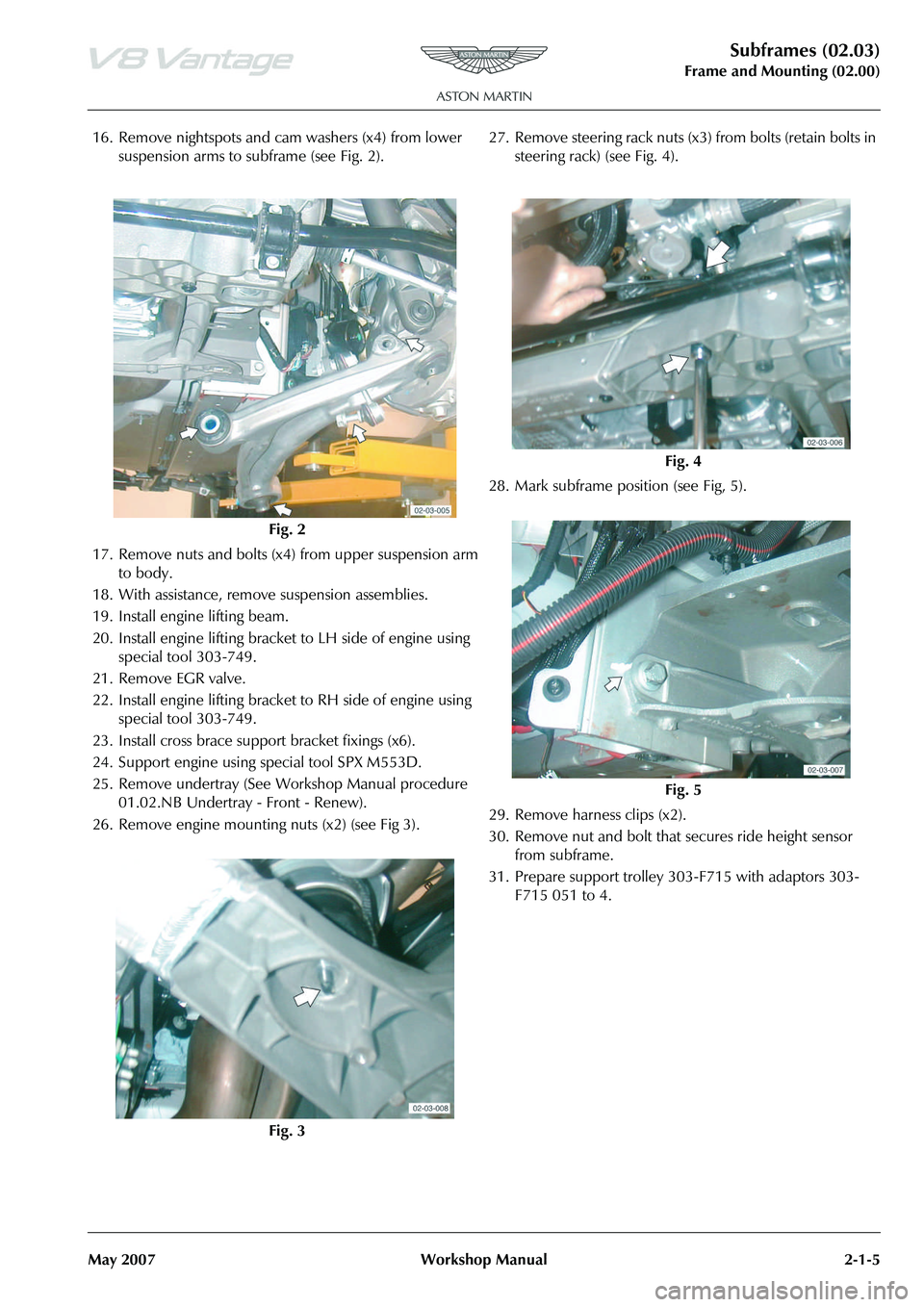
Subframes (02.03)
Frame and Mounting (02.00)
May 2007 Workshop Manual 2-1-5
16. Remove nightspots and cam washers (x4) from lower suspension arms to subframe (see Fig. 2).
17. Remove nuts and bolts (x4) from upper suspension arm to body.
18. With assistance, remove suspension assemblies.
19. Install engine lifting beam.
20. Install engine lifting bracket to LH side of engine using
special tool 303-749.
21. Remove EGR valve.
22. Install engine lifting bracket to RH side of engine using special tool 303-749.
23. Install cross brace support bracket fixings (x6).
24. Support engine using special tool SPX M553D.
25. Remove undertray (See Workshop Manual procedure 01.02.NB Undertray - Front - Renew).
26. Remove engine mounting nuts (x2) (see Fig 3). 27. Remove steering rack nuts (x3) from bolts (retain bolts in
steering rack) (see Fig. 4).
28. Mark subframe position (see Fig, 5).
29. Remove harness clips (x2).
30. Remove nut and bolt that secures ride height sensor
from subframe.
31. Prepare support trolley 30 3-F715 with adaptors 303-
F715 051 to 4.
Fig. 2
Fig. 3
Fig. 4
Fig. 5
Page 228 of 947
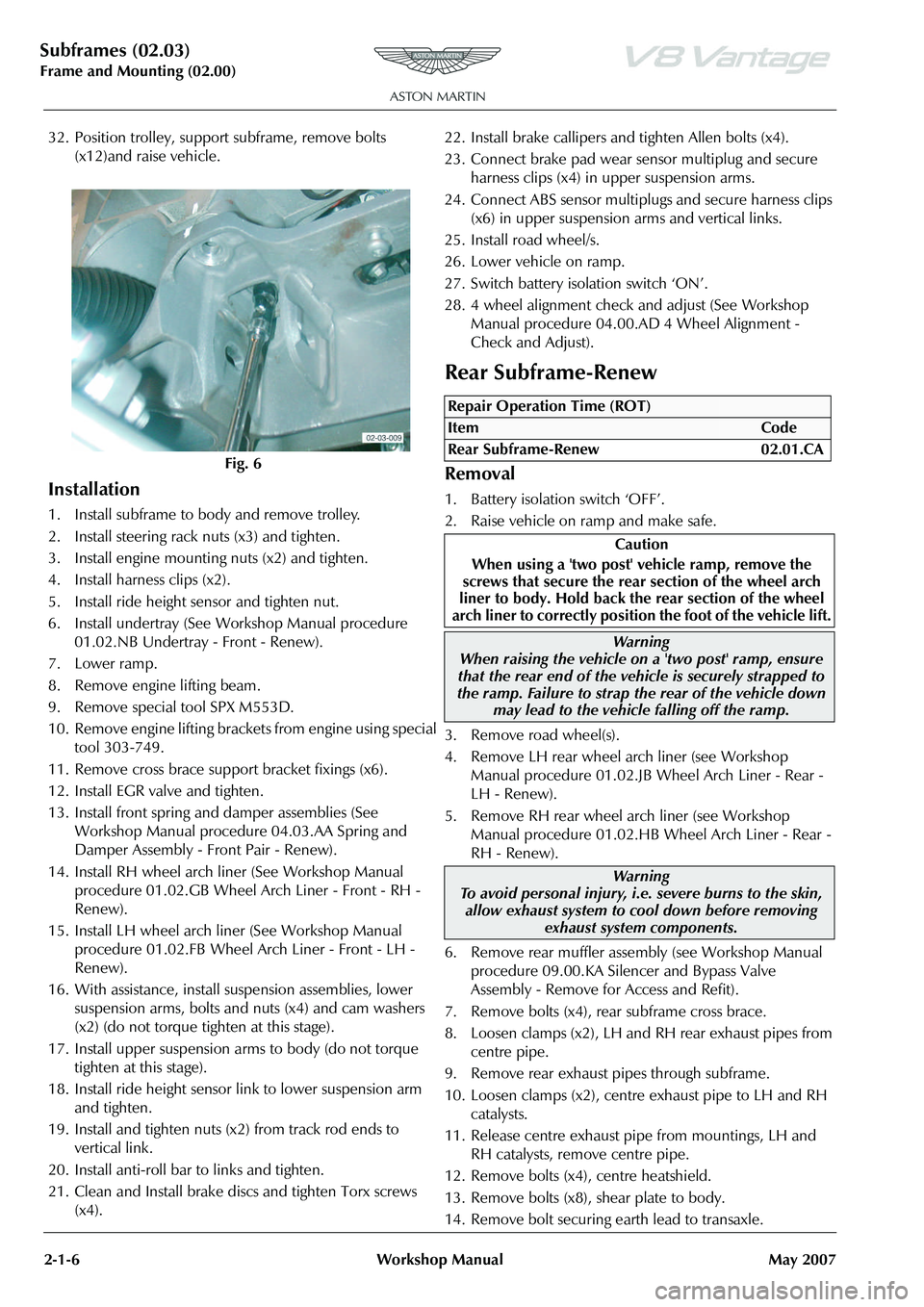
Subframes (02.03)
Frame and Mounting (02.00)
2-1-6 Workshop Manual May 2007
32. Position trolley, support subframe, remove bolts (x12)and raise vehicle.
Installation
1. Install subframe to body and remove trolley.
2. Install steering rack nuts (x3) and tighten.
3. Install engine mounting nuts (x2) and tighten.
4. Install harness clips (x2).
5. Install ride height sensor and tighten nut.
6. Install undertray (See Workshop Manual procedure 01.02.NB Undertray - Front - Renew).
7. Lower ramp.
8. Remove engine lifting beam.
9. Remove special tool SPX M553D.
10. Remove engine lifting bracket s from engine using special
tool 303-749.
11. Remove cross brace support bracket fixings (x6).
12. Install EGR valve and tighten.
13. Install front spring and damper assemblies (See Workshop Manual procedure 04.03.AA Spring and
Damper Assembly - Front Pair - Renew).
14. Install RH wheel arch liner (See Workshop Manual procedure 01.02.GB Wheel Arch Liner - Front - RH -
Renew).
15. Install LH wheel arch liner (See Workshop Manual procedure 01.02.FB Wheel Arch Liner - Front - LH -
Renew).
16. With assistance, install suspension assemblies, lower suspension arms, bolts and nuts (x4) and cam washers
(x2) (do not torque tighten at this stage).
17. Install upper suspension arms to body (do not torque tighten at this stage).
18. Install ride height sensor link to lower suspension arm and tighten.
19. Install and tighten nuts (x2) from track rod ends to vertical link.
20. Install anti-roll bar to links and tighten.
21. Clean and Install brake discs and tighten Torx screws (x4). 22. Install brake callipers and tighten Allen bolts (x4).
23. Connect brake pad wear se
nsor multiplug and secure
harness clips (x4) in upper suspension arms.
24. Connect ABS sensor multiplu gs and secure harness clips
(x6) in upper suspension arms and vertical links.
25. Install road wheel/s.
26. Lower vehicle on ramp.
27. Switch battery isolation switch ‘ON’.
28. 4 wheel alignment check and adjust (See Workshop Manual procedure 04.00.AD 4 Wheel Alignment -
Check and Adjust).
Rear Subframe-Renew
Removal
1. Battery isolation switch ‘OFF’.
2. Raise vehicle on ramp and make safe.
3. Remove road wheel(s).
4. Remove LH rear wheel arch liner (see Workshop Manual procedure 01.02.JB Wheel Arch Liner - Rear -
LH - Renew).
5. Remove RH rear wheel arch liner (see Workshop Manual procedure 01.02.HB Wheel Arch Liner - Rear -
RH - Renew).
6. Remove rear muffler asse mbly (see Workshop Manual
procedure 09.00.KA Silencer and Bypass Valve
Assembly - Remove for Access and Refit).
7. Remove bolts (x4), rear subframe cross brace.
8. Loosen clamps (x2), LH and RH rear exhaust pipes from
centre pipe.
9. Remove rear exhaust pipes through subframe.
10. Loosen clamps (x2), centre exhaust pipe to LH and RH
catalysts.
11. Release centre exhaust pipe from mountings, LH and RH catalysts, remove centre pipe.
12. Remove bolts (x4), centre heatshield.
13. Remove bolts (x8), shear plate to body.
14. Remove bolt securing earth lead to transaxle.
Fig. 6
Repair Operation Time (ROT)
ItemCode
Rear Subframe-Renew 02.01.CA
Caution
When using a 'two post' vehicle ramp, remove the
screws that secure the rear section of the wheel arch
liner to body. Hold back the rear section of the wheel
arch liner to correctly position the foot of the vehicle lift.
Warning
When raising the vehicle on a 'two post' ramp, ensure
that the rear end of the vehi cle is securely strapped to
the ramp. Failure to strap th e rear of the vehicle down
may lead to the vehicl e falling off the ramp.
Warning
To avoid personal injury, i.e. severe burns to the skin, allow exhaust system to cool down before removing
exhaust system components.
Page 230 of 947
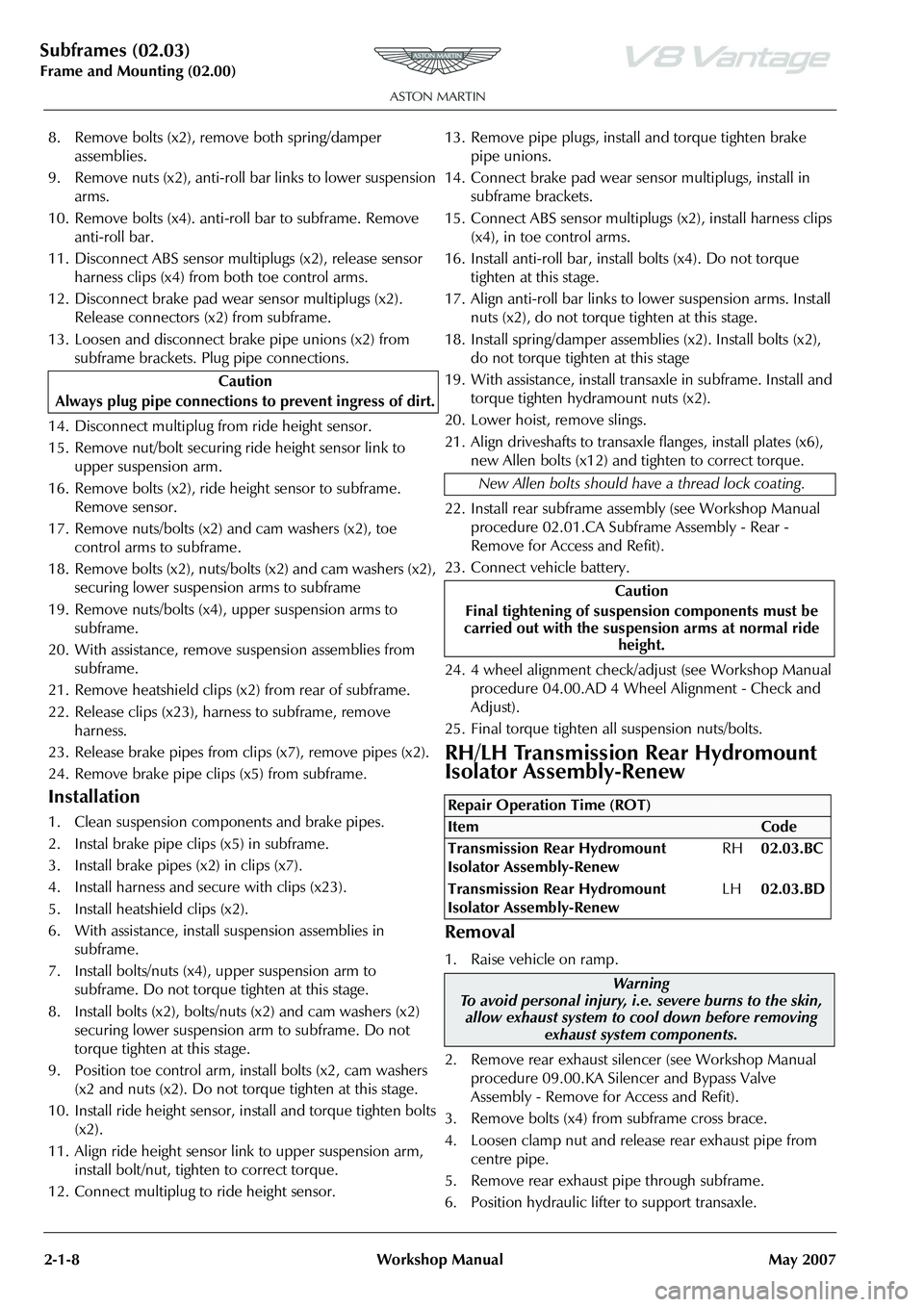
Subframes (02.03)
Frame and Mounting (02.00)
2-1-8 Workshop Manual May 2007
8. Remove bolts (x2), remove both spring/damper assemblies.
9. Remove nuts (x2), anti-roll bar links to lower suspension
arms.
10. Remove bolts (x4). anti-roll bar to subframe. Remove anti-roll bar.
11. Disconnect ABS sensor mult iplugs (x2), release sensor
harness clips (x4) from both toe control arms.
12. Disconnect brake pad wear sensor multiplugs (x2). Release connectors (x2) from subframe.
13. Loosen and disconnect brake pipe unions (x2) from subframe brackets. Pl ug pipe connections.
14. Disconnect multiplug fr om ride height sensor.
15. Remove nut/bolt securing ride height sensor link to
upper suspension arm.
16. Remove bolts (x2), ride height sensor to subframe. Remove sensor.
17. Remove nuts/bolts (x2) and cam washers (x2), toe control arms to subframe.
18. Remove bolts (x2), nuts/bolts (x2) and cam washers (x2),
securing lower suspension arms to subframe
19. Remove nuts/bolts (x4), upper suspension arms to subframe.
20. With assistance, remove suspension assemblies from subframe.
21. Remove heatshield clips (x2) from rear of subframe.
22. Release clips (x23), ha rness to subframe, remove
harness.
23. Release brake pipes from cl ips (x7), remove pipes (x2).
24. Remove brake pipe clips (x5) from subframe.
Installation
1. Clean suspension components and brake pipes.
2. Instal brake pipe clips (x5) in subframe.
3. Install brake pipes (x2) in clips (x7).
4. Install harness and secure with clips (x23).
5. Install heatshield clips (x2).
6. With assistance, install suspension assemblies in subframe.
7. Install bolts/nuts (x4), upper suspension arm to subframe. Do not torque tighten at this stage.
8. Install bolts (x2), bolts/nuts (x2) and cam washers (x2) securing lower suspension arm to subframe. Do not
torque tighten at this stage.
9. Position toe control arm, install bolts (x2, cam washers (x2 and nuts (x2). Do not torque tighten at this stage.
10. Install ride height sensor, in stall and torque tighten bolts
(x2).
11. Align ride height sensor li nk to upper suspension arm,
install bolt/nut, tighten to correct torque.
12. Connect multiplug to ride height sensor. 13. Remove pipe plugs, install and torque tighten brake
pipe unions.
14. Connect brake pad wear sensor multiplugs, install in subframe brackets.
15. Connect ABS sensor multiplugs (x2), install harness clips (x4), in toe control arms.
16. Install anti-roll bar, install bolts (x4). Do not torque tighten at this stage.
17. Align anti-roll bar links to lower suspension arms. Install nuts (x2), do not torque tighten at this stage.
18. Install spring/damper assemblies (x2). Install bolts (x2), do not torque tighten at this stage
19. With assistance, install transaxle in subframe. Install and torque tighten hydramount nuts (x2).
20. Lower hoist, remove slings.
21. Align driveshafts to transaxle flanges, install plates (x6), new Allen bolts (x12) and tighten to correct torque.
22. Install rear subframe asse mbly (see Workshop Manual
procedure 02.01.CA Subframe Assembly - Rear -
Remove for Access and Refit).
23. Connect vehicle battery.
24. 4 wheel alignment check/adjust (see Workshop Manual procedure 04.00.AD 4 Wheel Alignment - Check and
Adjust).
25. Final torque tighten all suspension nuts/bolts.
RH/LH Transmission Rear Hydromount
Isolator Assembly-Renew
Removal
1. Raise vehicle on ramp.
2. Remove rear exhaust silenc er (see Workshop Manual
procedure 09.00.KA Silencer and Bypass Valve
Assembly - Remove for Access and Refit).
3. Remove bolts (x4) from subframe cross brace.
4. Loosen clamp nut and release rear exhaust pipe from centre pipe.
5. Remove rear exhaust pipe through subframe.
6. Position hydraulic lift er to support transaxle.
Caution
Always plug pipe connections to prevent ingress of dirt.
New Allen bolts should have a thread lock coating.
Caution
Final tightening of suspension components must be
carried out with the suspensi on arms at normal ride
height.
Repair Operation Time (ROT)
ItemCode
Transmission Rear Hydromount
Isolator Assembly-Renew RH
02.03.BC
Transmission Rear Hydromount
Isolator Assembly-Renew LH
02.03.BD
Warning
To avoid personal injury, i.e. severe burns to the skin, allow exhaust system to cool down before removing
exhaust system components.
Page 426 of 947
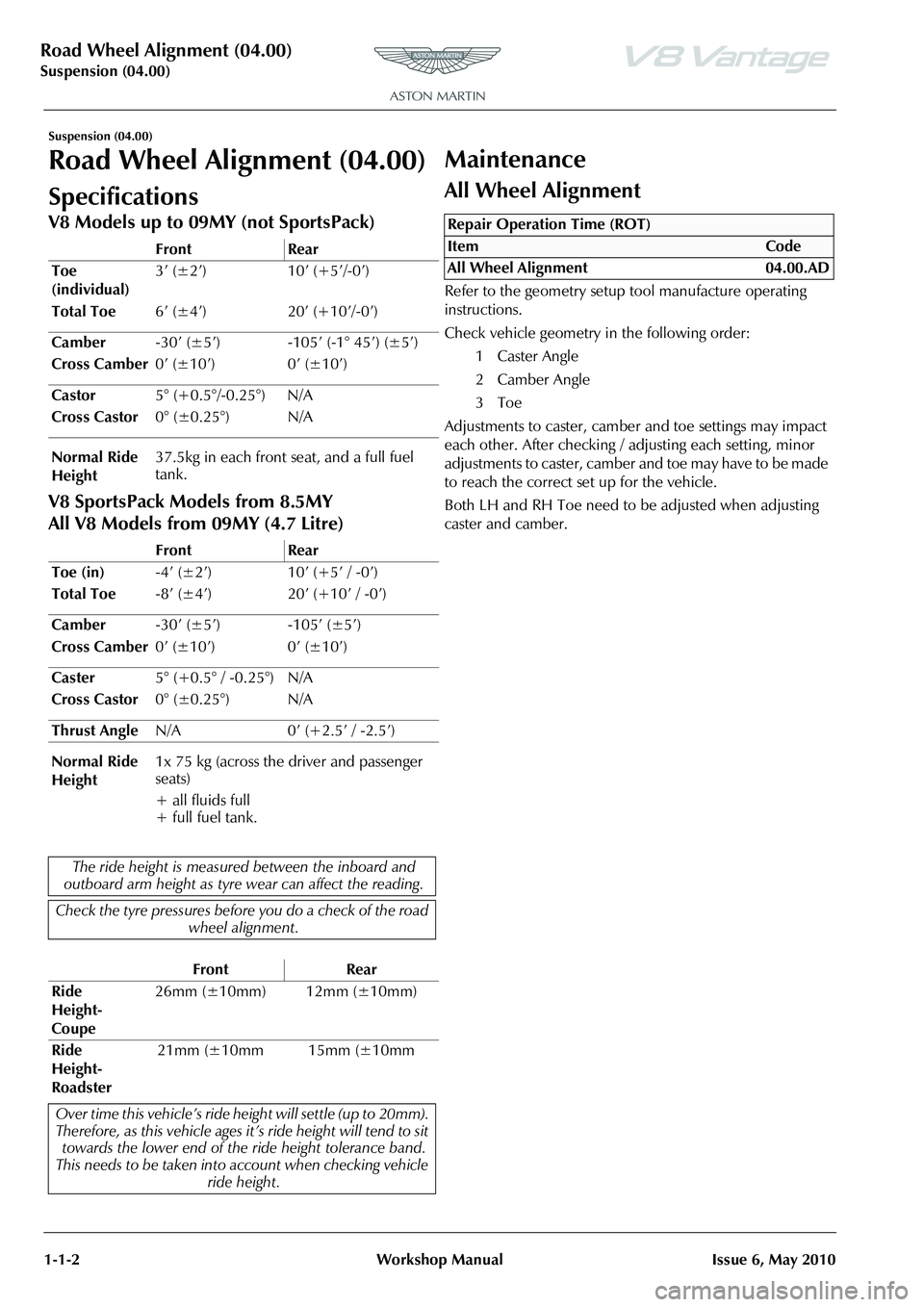
Road Wheel Alignment (04.00)
Suspension (04.00)1-1-2 Workshop Manual Issue 6, May 2010
Suspension (04.00)
Road Wheel Alignment (04.00)
Specifications
V8 Models up to 09MY (not SportsPack)
V8 SportsPack Models from 8.5MY
All V8 Models from 09MY (4.7 Litre)
Maintenance
All Wheel Alignment
Refer to the geometry setup tool manufacture operating
instructions.
Check vehicle geometry in the following order:
1 Caster Angle
2 Camber Angle
3Toe
Adjustments to caster, camber and toe settings may impact
each other. After checking / adjusting each setting, minor
adjustments to caster, camber and toe may have to be made
to reach the correct set up for the vehicle.
Both LH and RH Toe need to be adjusted when adjusting
caster and camber.
Front Rear
Toe
(individual) 3’ (±2’) 10’ (+5’/-0’)
Total Toe 6’ (±4’) 20’ (+10’/-0’)
Camber -30’ (±5’) -105’ (-1° 45’) (±5’)
Cross Camber 0’ (±10’) 0’ (±10’)
Castor 5° (+0.5°/-0.25°) N/A
Cross Castor 0° (±0.25°) N/A
Normal Ride
Height 37.5kg in each front seat, and a full fuel
tank.
Front Rear
Toe (in) -4
Page 427 of 947

Front Suspension (04.01)
Suspension (04.00)
November 2008 Workshop Manual 4-1-1
Suspension (04.00)
Front Suspension (04.01)
Description
Suspension Arms
The upper suspension arm is attached to the body structure.
The lower suspension arm is attached to the front subframe.
Each upper suspension arm has a press-fit ball-joint, and two
interleaved rubber bushes. Two bolts attach the upper
suspension arm to the body structure.
Each lower suspension arm has a press fit ball-joint and
metal-to-rubber bonded bushes which are attached to the
front subframe by two eccentric cam bolts (Camber and
castor settings).
Anti-roll Bar
The anti-roll bar, is attached to the subframe in two positions
by rubber bushes and clamps. The outer ends of the anti-roll
bar are attached to the lower suspension arms by drop links.
The anti-roll bar provides the required stiffness to control
body roll.
Vertical link
The Vertical link (Knuckle Joint) swivels on the upper and
lower suspension arms via ball-joints, and carries the hub, a
unit 3 wheel bearing (including the ABS encoder ring), the
wheel speed sensor, the brake caliper, and the brake disc
and shield. The position of the Vertical link is determined by
the movement of the steering rack, which is connected to
the Vertical link by the steering track rod.
Specifications
Upper Arm Ball Joint
and Bushes
Ball Joint
and Bushes Verticle
Link
Bolts to Body
Lower Arm
Anti-roll Bar Drop Links
Eccentric
Cam Bolts
04-01-003
Torque Figures
DescriptionNmlb. / ft.
Brake dust shield. 9 7
Bearing Assembly to the Vertical
link. 55 41
Vertical Link to the Lower
Suspension Arm. 90 66.5
Vertical Link to the Upper
Suspension Arm. 90 66.5
Track-rod End Lock Nut. 70 52
Vehicle Ride Height Sensor. M8 M522.5
9 17
7
Anti-roll Bar Link Nuts 110 81.5
Anti-roll Bar Mounting Bolts
Torque bolt 1, then bolt 2, then
bolt 1 again (to allow for rubber
compression) 22.5 17
Torque the following suspensi on fixings with the vehicle
at normal ride height
Lower Suspension Arm front
bush to the Subframe M14 185 137
Lower Suspension Arm rear
bush to the Subframe. M12 115 85
Upper Suspension Arm to the
Front Structure 115 85
Spring and Damper Bolts Top Lower22.5
175 17
129.5
Normal ride height 2 x 37.5kg in front seats (37.5kg in
each seat) plus a full fuel tank.
Page 428 of 947

Front Suspension (04.01)
Suspension (04.00)4-1-2 Workshop Manual November 2008
Symptoms
SymptomPossible CauseAction
Crabbing Front or rear suspension components/road
wheel alignment Inspect front and rear suspension systems.
Check / adjust road wheel alignment
Drive axle damaged New drive axle.
Front ‘Bottoming’
or Riding Low Spring(s)
Dampers Check ride height.
Check dampers.
Drift/Pull Unequal tyre pressure Check / adjust tyre pressures.
Inspect tyre for excessive wear.
Incorrect road wheel alignment Check / adjust road wheel alignment.
Tyres Check / adjust tyre pressu res. Inspect tyre for excessive
wear.
Unevenly loaded or overloaded vehicle Not ify customer of incorrect vehicle loading .
Damaged steering components Check steering sy stem for mechanical or hydraulic bias.
Brake drag Check brakes.
Check steering system for mechanical or hydraulic bias.
Rough Ride Spring(s) Check springs.
Shock absorber(s) Check shock absorbers.
Incorrect Tyre
Wear Incorrect tyre pressure Check and adju
st tyre pressure. Inspect tyre for
excessive wear.
Excessive front or rear Toe (rapid inner or
outer edge wear) Check and adjust road wheel alignment (Refer to ’Road
Wheel Alignment (04.00)’, page 4-0-2).
Excessive negative or positive camber
(rapid or outer edge wear) Check and adjust road wheel alignment (Refer to ’Road
Wheel Alignment (04.00)’, page 4-0-2).
Tyres out of balance (tyres cupped or
dished) Balance tyres.
‘Shimmy’ or ‘Road
Wheel Tramp’ Loose road wheel nut(s) Check and tighten road wheel nuts to specification.
Loose front suspension Check and tighten
suspension fixings to specification.
Front road wheel bearing(s) Check road wheel bearings.
Road wheel / tyres Check road wheels / tyres.
Shock absorber(s) Check shock absorbers.
Spring(s) Check springs.
Loose, worn or damaged ball -joint(s) Check ball-joint(s).
Loose, worn or damaged steering
components Check components.
Front road wheel alignment Check and adjust road wheel alignment (Refer to ’Road Wheel Alignment (04.00)’, page 4-0-2).
Worn or damaged suspension bushes Check suspension bushes
Poor ‘Return
ability’ of Steering ball-joints Check ball-joint(s).
Steering components Check for excessive friction in steering system.
Check tyre pressures
Steering Wheel
Off-Centre Unequal front or rear Toe settings Check and adjust road wheel alignment.
Steering components Check and install new components as required.
Sway or Roll Overloaded, unevenly or incorrectly
loaded vehicle Notify customer of incorrect vehicle loading
Loose road wheel nut(s) Check. Tighten road wheel nut(s) to specification
Spring(s) Check. Install new springs as required.
Shock absorber(s) Check. Install new shock absorbers as required.
Loose front stabilizer bar or rear stabilizer
bar Check. Tighten anti-roll bar to specification.
Page 429 of 947
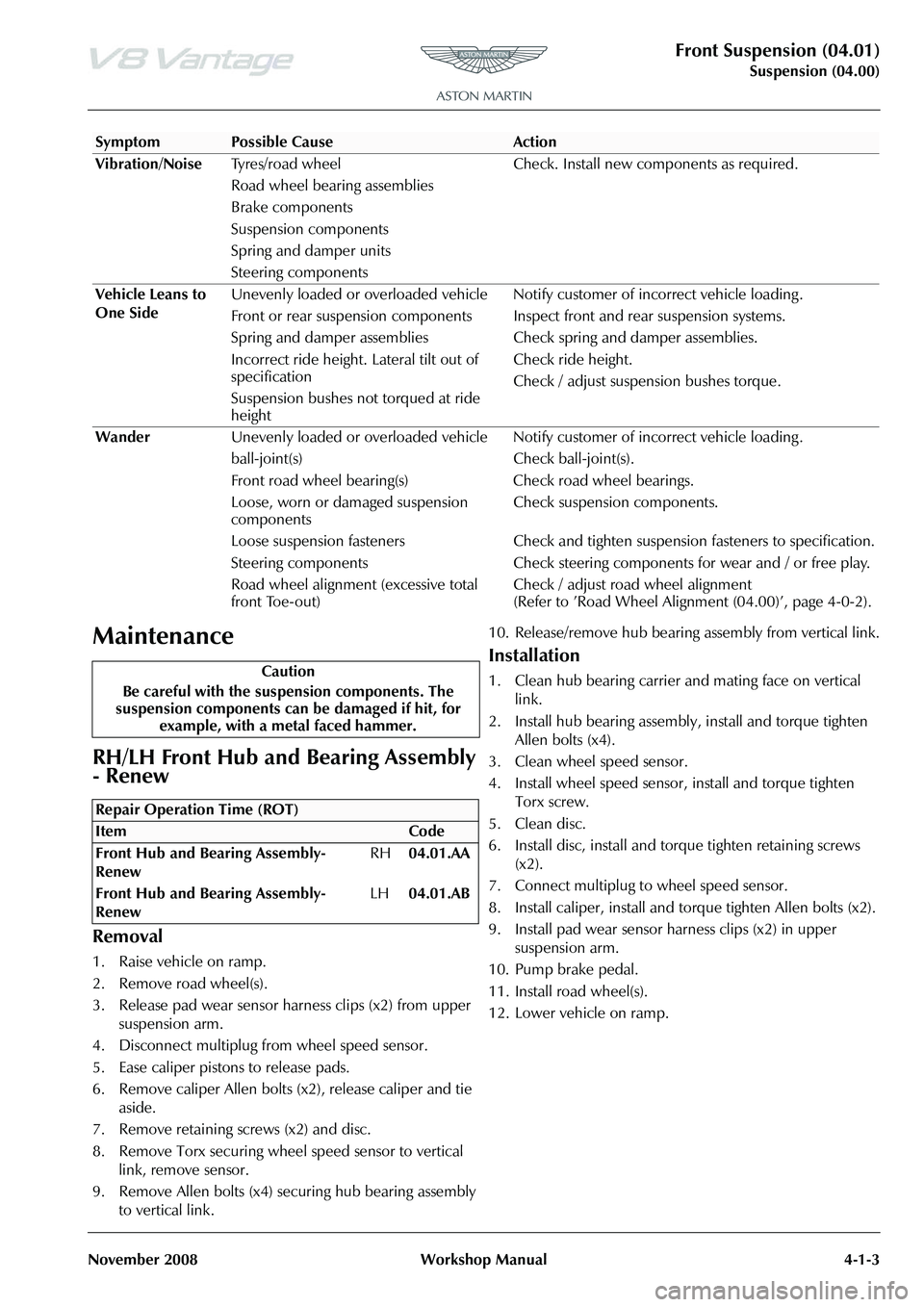
Front Suspension (04.01)
Suspension (04.00)
November 2008 Workshop Manual 4-1-3
Maintenance
RH/LH Front Hub and Bearing Assembly
- Renew
Removal
1. Raise vehicle on ramp.
2. Remove road wheel(s).
3. Release pad wear sensor harness clips (x2) from upper suspension arm.
4. Disconnect multiplug from wheel speed sensor.
5. Ease caliper pistons to release pads.
6. Remove caliper Allen bolts (x2), release caliper and tie
aside.
7. Remove retaining screws (x2) and disc.
8. Remove Torx securing wheel speed sensor to vertical link, remove sensor.
9. Remove Allen bolts (x4) securing hub bearing assembly to vertical link. 10. Release/remove hub bearing assembly from vertical link.
Installation
1. Clean hub bearing carrier and mating face on vertical
link.
2. Install hub bearing assembly, install and torque tighten Allen bolts (x4).
3. Clean wheel speed sensor.
4. Install wheel speed sensor, install and torque tighten Torx screw.
5. Clean disc.
6. Install disc, install and torque tighten retaining screws (x2).
7. Connect multiplug to wheel speed sensor.
8. Install caliper, install and to rque tighten Allen bolts (x2).
9. Install pad wear sensor harness clips (x2) in upper suspension arm.
10. Pump brake pedal.
11. Install road wheel(s).
12. Lower vehicle on ramp.
Vibration/Noise
Tyres/road wheel
Road wheel bearing assemblies
Brake components
Suspension components
Spring and damper units
Steering components Check. Install new components as required.
Vehicle Leans to
One Side Unevenly loaded or overloaded vehicle Notif
y customer of incorrect vehicle loading .
Front or rear suspension components Inspect front and rear suspension systems.
Spring and damper assemblies Check spring and damper assemblies.
Incorrect ride height. Lateral tilt out of
specification
Suspension bushes not torqued at ride
height Check ride height.
Check / adjust suspension bushes torque.
Wander Unevenly loaded or overloaded vehicle Notif y customer of incorrect vehicle loading .
ball-joint(s) Check ball-joint(s).
Front road wheel bearing(s) Check road wheel bearings.
Loose, worn or damaged suspension
components Check suspension components.
Loose suspension fasteners Check and tighten suspension fasteners to specification.
Steering components Check steering components for wear and / or free play.
Road wheel alignment (excessive total
front Toe-out) Check / adjust road wheel alignment
(Refer to ’Road Wheel Alignment (04.00)’, page 4-0-2).
SymptomPossible CauseAction
Caution
Be careful with the suspension components. The
suspension components can be damaged if hit, for example, with a metal faced hammer.
Repair Operation Time (ROT)
Page 430 of 947

Front Suspension (04.01)
Suspension (04.00)4-1-4 Workshop Manual November 2008
RH/LH Lower Front Suspension Arm
Assembly - Renew
Removal
1. Raise vehicle on ramp.
2. Remove road wheel(s).
3. Remove nut/washer securing anti-roll bar link to lower suspension, release link from arm.
4. Remove nut/bolt securing damper to lower suspension arm, release damper from mounting.
5. Remove nut securing lower suspension arm ball-joint to vertical link.
6. Install tool (204 - 523) ba ll-joint remover and release
lower suspension ball-joi nt from vertical link.
7. Mark fitted positions of cam washers on lower suspension arm inner fixings to aid assembly purpose.
8. Remove nuts/bolts, cam washers (x2), securing lower suspension arm to subframe.
9. Release/remove lower suspension arm from subframe and vertical link.
Installation
1. Clean lower suspension arm and mating faces on vertical link and subframe
2. Install lower suspension arm in subframe.
3. Install cam washers, bolts/nuts (x2). Align cam washers to marks. Do not torque tighten at this stage.
4. Install lower suspension arm ball-joint in vertical link. Install and torque tighten nut.
5. Align damper to mounting, install bolt/nut. Do not torque tighten at this stage.
6. Install anti-roll bar link, install washer/nut. Do not torque tighten at this stage.
7. Final tightening of suspen sion components must be
carried out with the suspensi on arms at normal ride
height.
8. Install road wheel(s).
9. Lower vehicle on ramp.
10. Torque tighten suspension nuts/bolts.
11. 4 wheel alignment - check/adjust (see Workshop Manual procedure 04.00.AD 4 Wheel Alignment -
Check and Adjust).
RH/LH Upper Front Suspension Arm
Assembly - Renew
Removal
1. Raise the vehicle and make it safe.
2. Remove the road wheel for the applicable suspension arm.
3. Disconnect the electrical connector from the ABS sensor.
4. Release the three sensor harness clips from the upper suspension arm and the vertical link.
5. Remove the two Torx screws that attach the engine cross brace to the mounting.
6. Remove the two nuts and two bolts that attach the upper suspension arm to the body.
7. Release the suspension arm from the body.
8. Remove the three nuts that attach the damper top mounting.
9. Remove the mounting for the engine cross brace.
10. Remove the nut and bolt that attaches the damper to its lower mounting.
11. Remove spring/damper assembly.
12. Remove the nut that attaches the ball-joint for the upper suspension arm to the vertical link.
13. Install tool (204 - 523 - ball-joint remover) and release the ball-joint from vertical link.
14. Remove the upper suspension arm assembly.
Installation
1. Clean the upper suspension arm and the mating faces on the body and the vertical link.
2. Install the upper suspension arm to vertical link. Install the nut but do not torque tighten at this step.
3. Install spring/damper assembly.
4. Install the cross-brace support.
5. Install the three nuts but do not torque tighten at this step.
6. Align the damper to the lower mounting, install bolt/nut. Do not torque tighten at this step.
7. Put the upper suspension arm in positionon the body.
8. Install bolts and nuts but do not torque tighten at this step.
9. Connect the electrical connector to the ABS sensor.
Repair Operation Time (ROT)Repair Operation Time (ROT)
ItemCode
Upper Front Suspension Arm
Assembly-Renew RH
04.01.AE
Upper Front Suspension Arm
Assembly-Renew LH
04.01.AF
Caution
Be carefulthat you do not damage the ball-joint rubber
boot when you use the special tool.
Page 431 of 947

Front Suspension (04.01)
Suspension (04.00)
November 2008 Workshop Manual 4-1-5
10. Install the three sensor harness clips in the upper suspension and the vertical link.
11. Install the road wheel.
12. Lower the vehicle on ramp.
13. Do an all-wheel alignment procedure (Refer to ’All
Wheel Alignment’, page 4-0-2).
14. Torque tighten suspension nuts and bolts.
15. Align engine cross brace to support, install and torque tighten Torx bolts (x2).
Front Anti-Roll Bar - Renew
Removal
1. Raise vehicle on ramp.
2. Remove road wheel(s).
3. Remove front undertray (see Workshop Manual procedure 01.02.NB Undertray - Front - Renew).
4. Remove nuts and washers (x2), anti-roll bar to drop links.
5. Remove bolts (x4), straps (x2).
6. Remove anti-roll bar.
7. Remove bushes (x2) from anti-roll bar.
Installation
1. Clean anti-roll bar, bushes and straps.
2. Install bushes (x2) on anti-roll bar.
3. Position anti-roll bar, align bushes (x2), install straps (x2), install bolts (x4). Do not torque tighten.
4. Install drop links to anti-roll bar, install nuts/washers (x2).
Do not torque tighten.
5. Install front undertray (see Workshop Manual procedure 01.02.NB Undertray - Front - Renew).
6. Lower vehicle in ramp.
7. Torque tighten link nuts (x4).
8. Torque tighten bush strap bolts (x4).
Front Pair Anti-Roll Bar Bushing - Renew
Removal
1. Raise vehicle on ramp.
2. Remove front undertray (see Workshop Manual procedure 01.02.NB Undertray - Front - Renew).
3. Remove bolts (x4) securing anti-roll bar bush straps to subframe.
4. Release/remove bush straps.
5. Remove bushes (x2) from anti-roll bar.
Installation
1. Clean anti-roll bar and bush straps.
2. Install bushes on to anti-roll bar.
3. Install bush straps (x2), install bolts (x4). Do not torque tighten at this stage.
4. Install front undertray (see Workshop Manual procedure 01.02.NB Undertray - Front - Renew).
5. Lower vehicle on ramp.
6. Torque tighten all suspension nuts/bolts.
RH/LH Front Anti-Roll Bar Link - Renew
Removal
1. Raise vehicle on ramp.
2. Remove road wheel(s).
3. Remove nut/bolt securing damper to lower suspension
arm.
4. Release damper from mounting sufficient to remove top anti-roll bar link.
5. Remove nuts and washers (x2) , link to lower suspension
arm and anti-roll bar.
6. Release and remove anti-roll bar link.
Installation
1. Clean anti-roll bar link and mating faces on lower suspension arm and anti-roll bar.
2. Install link to anti-roll bar and lower suspension arm.
3. Install washers (x2) and nuts (x2). Do not torque tighten.
Caution
Do not fully tighten the nuts and bolts on the suspension
components. Only tighten the nuts and bolts of the
suspension components when the suspension arms are
at their usual ride-height and you have adjusted the
geometry. If you do not do this, the suspension bushes
will have too much stress when the suspension is moved
to its maximum upward travel.
Repair Operation Time (ROT)
Repair Operation Time (ROT)
Repair Operation Time (ROT)
Page 432 of 947

Front Suspension (04.01)
Suspension (04.00)4-1-6 Workshop Manual November 2008
4. Align damper to lower mounting, install bolt/nut. Do not torque tighten at this stage.
5. Install road wheel(s).
6. Lower vehicle in ramp.
7. Torque tighten link nuts (x2).
8. Torque tighten lower damper bolt.RH/LH Front Hub Vertical Link - Renew
Removal
1. Raise vehicle on ramp.
2. Remove road wheel(s).
3. Install tool (204 - 524) on front hub, install and tighten wheel nuts.
4. Lower vehicle to raise suspension sufficient to install ball-joint removing tool (204 - 523).
5. Remove track rod end from vertical link (using tool 204- 523).
6. Remove pad wear sensors.
7. Remove ABS sensor multiplug.
8. Remove Torx screw securing ABS sensor, remove sensor.
9. Ease caliper pistons to release pads.
10. Remove caliper Allen bolts (x2), release caliper and tie caliper aside.
11. Remove brake disc Torx screws (x2), remove disc.
12. Release lower suspension arm from vertical link (using tool 204-523).
13. Release vertical link from upper suspension arm (using tool 204-523). Remove vertical link assembly.
14. Remove Allen bolts (x4) se curing hub bearing assembly
to vertical link.
15. Release/remove hub bearing a ssembly from vertical link.
16. Remove Torx screws (x4), di sc shield to vertical link.
Remove shield.
Installation
1. Clean vertical link, hub bearing carrier and disc shield.
2. Position disc shield to vertical link, install and torque tighten Torx screws (x4).
3. Install hub bearing assembly in vertical link, install Allen
bolts (x4) and tighten.
4. Install vertical link assembly to upper suspension arm. Install and torque tighten nut.
5. Install vertical link in lowe r suspension arm. Install and
torque tighten nut.
6. Clean brake disc.
7. Install brake disc. Install an d torque tighten Torx screws
(x2).
Caution
Do not fully tighten the nuts and bolts on the suspension
components. Only tighten th e nuts and bolts of the
suspension components when the suspension arms are
at their usual ride-height and you have adjusted the
geometry. If you do not do this, the suspension bushes
will have too much stress when the suspension is moved
to its maximum upward travel.
Repair Operation Time (ROT)
ItemCode
Front Hub Vertical Link-Renew RH04.01.CB
Front Hub Vertical Link-Renew LH04.01.DB
Caution
Do not fully tighten the nuts and bolts on the suspension
components. Only tighten the nuts and bolts of the
suspension components when the suspension arms are
at their usual ride-height and you have adjusted the
geometry. If you do not do this, the suspension bushes
will have too much stress when the suspension is moved
to its maximum upward travel.